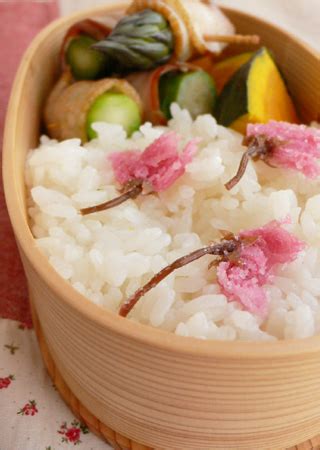In Japan, cherry blossoms, better known as “sakura” in the Japanese language, are much more than simply a spectacle of fleeting botanical beauty; they are also deeply embedded in the nation’s culture. Their splendid display captivates both locals and visitors from abroad alike. As spring rolls out its yearly tapestry of vibrancy throughout the Japanese archipelago, the elegant charm of cherry blossoms in full bloom is eagerly anticipated by many, and fervent preparations begin for the annual celebration of this parade of pink and white.

Cherry blossom viewing parties, referred to as “hanami” in Japanese, are a unique tradition full of exquisite and memorable revelry. These lively gatherings are the highlight of cherry blossom reverence and herald the end of frigid winter days and the approach of spring, with its bounty sensory enchantments.
The term “hanami” describes the tradition of enjoying the transient beauty of cherry blossoms, and is a derived from the combination of two characters: ‘hana,’ (花) meaning flower, and ‘mi,’ (見) which means to ‘look at’ or ‘view’ something.”. Amid growing hints of springtime’s splendid arrival, hanami celebrations offer friends, family, and colleagues an opportunity to gather together once again and rehash the previous years joys and sorrows, while relishing in the dazzling procession of this delicate and ephemeral floral display.
The anticipation for hanami is not limited to just the day of the event. In the weeks leading up to the festivities, individuals can be seen scouting for the perfect viewing spots, discussing weather forecasts with friends, and preparing the perfect picnic menu. This communal excitement builds with each passing day, fostering a sense of shared anticipation across communities.
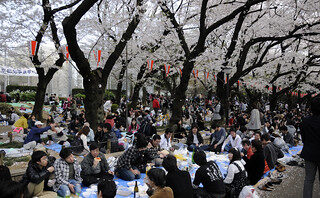
The shared memories of past hanami celebrations become a vital part of the experience. People fondly reminisce about the laughter, the shared meals, and the beauty of the blossoms. These recollections, passed down through generations, add a layer of emotional depth to the hanami tradition, making it not just a yearly event but a cherished legacy.
A prominent and time-honored theme in Japanese springtime culture, hanami parties transform typically tranquil public parks into vibrant hubs of often raucous festivity. Participants arrive at their chosen party spot early, and often even the night before, armed with blue tarps, a common feature in outdoor gatherings in Japan, affectionately referred to as “būru shīto” (blue sheets). The blue tarps serve two important purposes: one, to reserve the best possible blossom viewing spots, and two, to create a cozy space for maximum merriment.
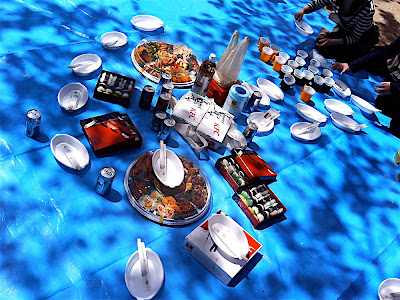
The atmosphere of a hanami party involves not only the blossoms but also the careful orchestration of a shared space. Families and friends take pride in creating their unique oasis, a space that reflects their camaraderie and joy. The meticulous setup becomes an art form, with each group adding their touch to the larger canvas of the park.
As guests arrive, they remove their shoes and place them on the outside edge of their group’s blue tarp and move on to the tarps to sit down and join the fun. Potlucks filled with delectable treats and an array of beverages are placed in the center. Soft lights hang from the trees and wind their way throughout the small flowers, creating a mosaic of colors and sounds spread out beneath the sea of pink.
Hanami parties commonly feature easy to eat Japanese finger foods such as sushi rolls, onigiri (rice balls), and grilled skewered meats and vegetables dominate the menu, but participants often bring their own culinary creations to share as well.
The wide variety of food and drink choices available at hanami parties reflects not only individual preferences but also the culinary diversity within Japan. It’s a tapestry of flavors mirroring the broader cultural mosaic, where traditional and modern flavors coexist in unison.
Japan is well known for its liberal drinking culture, and retail establishments always offer an unimaginable variety of libations , including sake, beer, canned cocktails, and shochu – a Japanese vodka made from rice, sugar, sweet potatoes. Having a good variety and supply of drinks is a common feature at outdoor events in Japan and hanami parties are no exception.

But Japan is also a country that highly values public safety, and every year, in order to minimize the chance of overly enthusiastic hanami goers overindulging, which does happen on occasion, city and park officials stress the importance of exercising moderation when addressing visitors. It’s recommended to stay hydrated and pace oneself to ensure a harmonious and carefree celebration.
Amidst the fervor of hanami preparations, a deeper connection with nature unfolds. Beyond the meticulous planning of picnics and the reservation of prime viewing spots, there is a profound appreciation for the symbolic nature of the cherry blossoms themselves. In addition to their obvious visual appeal, sakura serve as a prominent symbol of the transience of life and the temporary, fading nature of youthful energy and beauty, a concept known in Japan as “mono no aware,” the beauty of transience. As petals gently fall, it becomes a poignant reminder to embrace the fleeting moments and find beauty in impermanence.
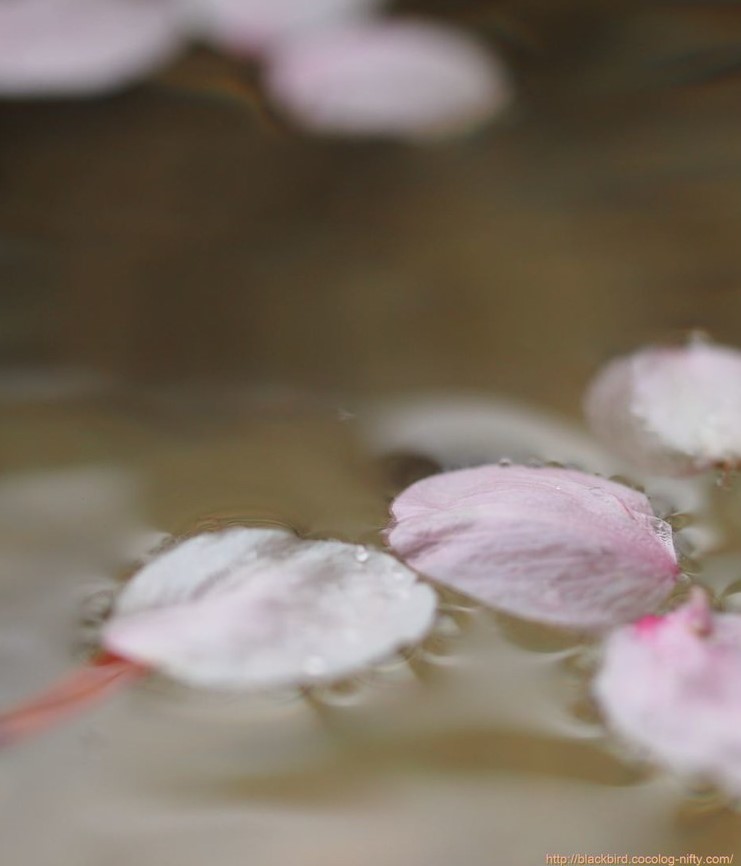
Delving into the historical roots of hanami unveils a fascinating journey through Japan’s past. The tradition has witnessed various phases of evolution, from aristocratic cherry blossom viewings during the Heian period to the integration of hanami into samurai culture during the Edo era. Understanding the historical context adds layers of depth to contemporary hanami celebrations, connecting present-day enthusiasts to the rich tapestry of Japan’s cultural heritage.
Due to their deeply beloved and romanticized nature in Japanese culture and sensibilities, the word ‘sakura’ features prominently in music, dramas, and place names. For generations this bittersweet sentiment has been a common theme in Japanese art and culture, resonating in the melodies of both traditional and contemporary Japanese music.
From ancient haiku poets to contemporary novelists, cherry blossoms serve as a muse for creative expression. Artists and writers use the transient beauty of sakura to explore themes of renewal, nostalgia, and the cyclical nature of life. Through their creations, they immortalize the essence of hanami, ensuring its enduring presence in cultural narratives.
“Sakura Sakura,” a timeless folk song that captures the essence of cherry blossoms has been passed down through generations, and modern artists continue to draw inspiration from sakura, infusing their compositions with the delicate and fleeting beauty synonymous with the blooming petals.

As cherry blossoms burst into full bloom, visual artists across Japan find inspiration in their delicate petals. Traditional Japanese art forms, such as ikebana (flower arranging) and ukiyo-e (woodblock prints), frequently incorporate sakura motifs. Contemporary artists also embrace this timeless symbol, creating vibrant and innovative pieces that fuse tradition with modernity. Hanami, thus, becomes a muse that transcends the boundaries of time and artistic expression.
The influence of cherry blossoms also extends to culinary realms, as chefs incorporate sakura-inspired ingredients into their creations. From sakura-infused teas to delicate pastries adorned with edible blossoms, the culinary world celebrates hanami with a gastronomic flourish. Exploring the diverse array of sakura-flavored delicacies becomes a delightful aspect of the hanami experience, adding a symphony of tastes to the visual spectacle.
The sakura season intertwines seamlessly with Japan’s rich tea culture. Tea ceremonies held beneath blooming cherry trees, known as “hanami tea parties,” add a layer of sophistication to the hanami tradition. The juxtaposition of serene tea rituals against the vibrant backdrop of falling petals creates a sensory experience , combining taste, aroma, and visual beauty. It is a moment of reflection and connection with nature, elevating the hanami celebration to a tranquil and spiritual realm.
While hanami remains deeply rooted in tradition, it has evolved over the years, adapting to societal changes. Modern hanami-goers may opt for themed gatherings, incorporating elements such as cosplay or outdoor film screenings into their celebrations. This evolution reflects the dynamic nature of Japanese culture, where tradition and innovation coexist harmoniously. Hanami, in its ever-changing form, continues to be a dynamic expression of joy and appreciation for nature’s fleeting beauty.
In an increasingly interconnected world, the spirit of hanami transcends physical boundaries. Virtual hanami experiences, facilitated by technology, enable enthusiasts worldwide to participate in the celebration. Livestreamed views of cherry blossoms in real-time, virtual reality hanami tours, and online forums for sharing hanami stories create a global community united by a shared love for sakura. This digital dimension adds a new layer to the traditional festivities, fostering a sense of unity among enthusiasts across the globe.
Capturing the magic of hanami has become an art form in itself. Modern technology, particularly smartphones with advanced camera capabilities, enable enthusiasts to document the beauty of cherry blossoms in unprecedented detail. From panoramic shots of sakura-lined avenues to close-ups of individual petals, technology enables individuals to create lasting visual memories of their hanami experiences. Social media platforms serve as digital albums, where people share their sakura snapshots, creating a virtual hanami gallery that everyone can enjoy.

As the popularity of hanami soars, there is a growing awareness of the need for sustainable practices. Eco-conscious individuals are exploring ways to minimize their environmental impact during cherry blossom festivities. From reusable picnicware to eco-friendly transportation options, these efforts contribute to preserving the beauty of sakura for generations to come. Embracing the transient beauty of cherry blossoms also extends to nurturing the environment that sustains them.
Thanks to the widespread appeal of sakura, both in Japan and abroad, there are many websites offering sakura forecasts. The Japan Weather Association provides one such annual sakura forecast (in Japanese) to assist enthusiasts in their hanami event planning. These kinds of forecasts help predict when cherry blossoms will appear in each region of the country, and can be a valuable resource for locals and tourists alike in making sure that no one misses their chance to witness these pink blooms at the peak of their grandeur.
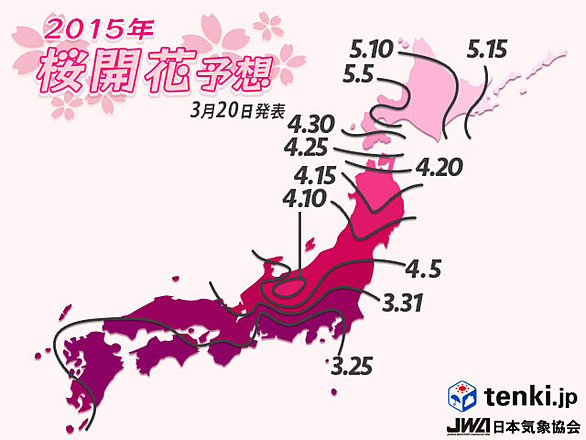
The accessibility of sakura forecasts in the digital age has added a layer of precision to the hanami planning process. Enthusiasts can now synchronize their schedules with the blossoming trees, ensuring that the moment of full bloom is not missed. It’s yet another testament to how technology has seamlessly integrated with traditional practices, enhancing the overall experience.
As Japan welcomes the arrival of spring, the country transforms into a canvas drenched in pink and white, courtesy of the much beloved sakura blooms. Images of festive celebrations under canopies of floral brilliance tinged with the poignance of impermanence create an alluring tapestry that captivates the imaginations of locals and visitors alike.
Sakura grace the entire archipelago from the vast island of Hokkaido in the north, to small islands of Okinawa in the south, and the number and variety of places to choose from for viewing is seemingly endless. Yet some cities tend to stand out as premier destinations when people think of traveling to experience hanami celebrations.
Tokyo, the bustling metropolitan capital of Japan, transforms into a sea of pink throughout the sakura season. Iconic parks like Ueno, Yoyogi, and Shinjuku’s Gyoen National Garden are renowned hot spots for hanami parties. And the ancient capital of Nara, with its serene parks and ancient temples, also offers a picturesque setting for cherry blossom viewing. Kyoto, often considered the cultural heart of Japan, showcases these delicate florets against a backdrop filled with geisha, historic temples, and traditional tea houses.
But while places like Tokyo and Kyoto often steal the spotlight during sakura season, Japan’s hidden gems can also offer a more intimate and secluded hanami experience. Venture off the beaten path to cities like Kanazawa or Takayama, where cherry blossoms gracefully frame historic streets and traditional architecture. These lesser-known destinations provide a serene backdrop for hanami enthusiasts seeking a quieter and more contemplative celebration.
As the sakura season unfolds its petals, the timeless allure of hanami continues to weave its magic across Japan. From traditional festivities to modern adaptations, the celebration of cherry blossoms remains a cherished cultural cornerstone. As we savor the beauty of fleeting petals and shared moments beneath blooming branches, let us embrace the essence of hanami—a celebration of life’s transience, the beauty of impermanence, and the enduring spirit of cultural unity.

Thanks to the recent affordability of the Japanese yen abroad and the improving quality of forecasting tools, 2024 is a perfect time to experience the annual pageant of the sakura. But unfortunately, they only stay with us briefly before they drop to the ground like delicate snowflakes. Their beauty serves as a vivid reminder that the seasons have shifted once again, and that warmer days are just around the bend. But they also gracefully remind us that life is fleeting, we all must savor and appreciate it while we can.

